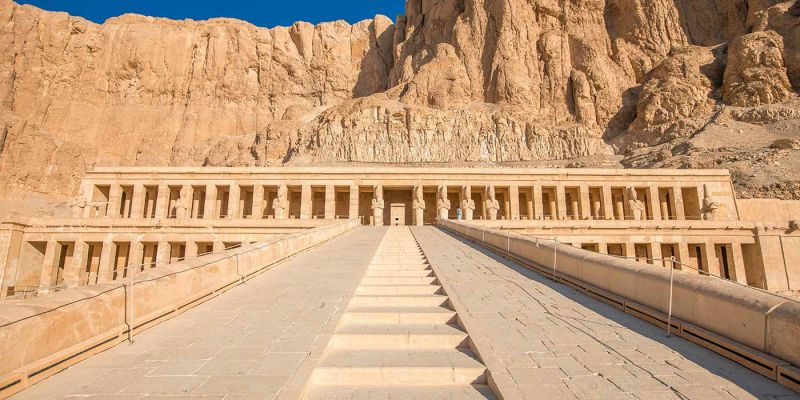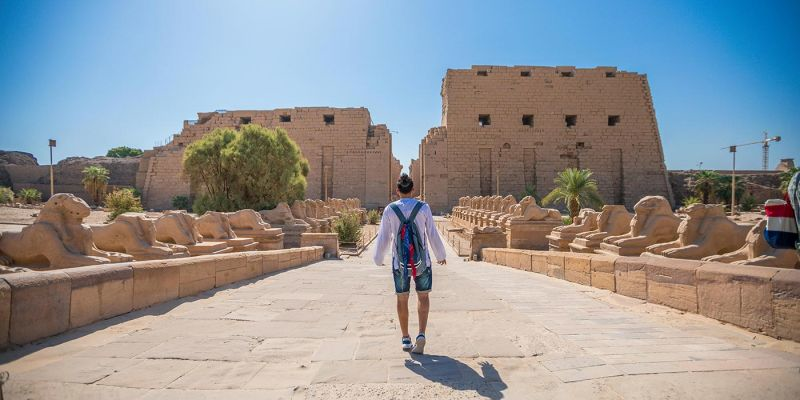-
Home
- Egypt
- Egypt Travel Guide
- Luxor Attractions
- Temple of Hatshepsut
Temple of Hatshepsut
Hatshepsut temple is a reflection of the mortuary temple of Mentuhotep II and was constructed alongside that 11th dynasty structure. Know more information about Temple of Hatshepsut!
.jpg)
Where is the Mortuary Temple of Hatshepsut?
The Mortuary Temple of Hatshepsut is located on the West bank of the Nile in Luxor. In terms of visual impact from afar, there is no rival to Hatshepsut’s Temples. The unique multi-tiered structure nestled up against the limestone cliffs at the shoulder of the river valley is a truly stunning sight. The uniqueness of its layout mirrors that of the pharaoh responsible for building it.
When was Hatshepsut's temple built?
The temple of Queen Hatshepsut was built 1470 BCE.
Hatshepsut was the only female pharaoh in the history of Ancient Egypt. She came to power during the New Kingdom after the death of her father, Tuthmose I, and her half-brother and husband, Tuthmose II, who succeeded her father on the throne.
She originally served as queen-regent to her husband's son by another wife, Tuthmose III, but seized the throne from him and managing to hold onto power until her death. However, Hatshepsut’s status as the only female to rule Egypt is not the only reason for her fame.
She was also a very successful pharaoh. She ruled over an era of peace and prosperity, expanding lucrative trade routes to the land of Punt in the south.

This accomplishment is immortalized in the relief carvings at her temple. She also contributed significantly to many temples, including Karnak. The temple was in ruins when it was discovered in the mid-19th century, having been heavily vandalized by Tuthmose III after he assumed the throne, presumably because Hatshepsut had kept him from power.
The site was also used as a monastery during the early centuries AD, which probably contributed to its deterioration. As a result, it has been heavily restored.
Most of the columns are not original and much of the relief paintings have not been well preserved. For this reason, the temple can be a bit disappointing close-up, especially given its popularity with tour groups.
This accomplishment is immortalized in the relief carvings at her temple. She also contributed significantly to many temples, including Karnak.

Customize Your Dream Vacation!
Get in touch with our local experts for an unforgettable journey.
Plan Your Trip
It developed over a period of 1500 years, added to by generation after generation of pharaohs and resulting in a collection of temples, sanctuaries, pylons, and other decorations that is unparalleled throughout Egypt.
While the height of its importance was during the New Kingdom and famous pharaohs such as Hatshepsut, Tuthmose III, Seti I and Ramesses II all contributed significant additions to the complex, construction continued into the Greco-Roman Period with the Ptolomies, Romans, and early Christians all leaving their mark here.
Temple Of Karnak Complex:
Karnak is divided into three compounds: the precinct of Amun, the precinct of Mut, and the precinct of Montu; however, for most visitors the largest of these, the precinct of Amun, is enough. Its complicated layout alone dwarfs every other site that you will visit in Egypt.
The precinct of Amun contains all of the most famous sections of the Karnak complex, including the dizzying Great Hypostyle Hall. This hall of 134 massive columns is one of the most impressive places in all of Egypt. Going into the detailed description of the different elements that make up the complex is a near endless task that we will leave to a tour guide.
Instead, we will simply suggest that you allow plenty of time to explore this huge complex and admire the many impressive sights within it. Imagine how awe-inspiring it must have been over 2000 thousand years ago when these huge structures were newly constructed.
Egypt Pyramids
- Dahshur Pyramids | Egypt Pyramids
- How Were the Pyramids Built?
- The Bent Pyramid at Dahshur
- Khafre Pyramid (Pyramid of Chefren)
- Pyramid of Khufu (Cheops Pyramid)
- Pyramid of Menkaure (Mykerinus Pyramid)
- Djoser Step Pyramid at Saqqara
- Giza Necropolis
- The City of Memphis, Egypt
- Saqqara Step Pyramid Egypt
- The Red Pyramid at Dahshur
ِAncient Egyptian History
- The Middle Kingdom of Ancient Egypt
- Alexander the Great | Egypt History
- Queen Hatshepsut
- King Tutankhamun Facts
- Salah Al-Din Al-Ayyubi
- King Ramses II: Facts, Accomplishments, Life and Death
- Sultan Mohammad Ali
- Amr Ibn Al-Aas
- The Old Kingdom of Ancient Egypt
- The New Kingdom of Ancient Egypt
- Greco-Roman Period
- Early Islamic Period in Egypt
- Mamluk and Ottoman Period
- Egypt in the Modern Era
- Behind the Throne: Exploring the Life and Reign of Queen Cleopatra of Egypt
Cairo Attractions
- Al Aqmar Mosque | Cairo | Egypt
- Sultan Al Mansur Qalawun Mosque
- Al Azhar Mosque
- Mosque of Amr ibn al-As: Egypt’s Oldest Mosque and a Living Chronicle of Faith
- Bab Zuweila
- Museum of Islamic Art
- Sultan Hassan Mosque & Madrasa | Islamic Cairo
- Ahmed Ibn Tulun Mosque
- Bayt Al Suhaymi in Cairo
- Cairo Opera House
- The Coptic Museum in Cairo
- The Egyptian Museum in Cairo
- El Ghorya | Attractions in Cairo Egypt
- Ben Ezra Synagogue | Coptic Cairo
- Khan El Khalili Bazaar
- Old Cairo and Coptic Cairo
- Salah El Din Citadel in Cairo | Egypt
- The Hanging Church | Coptic Cairo
- Al-Muizz Al-Deen Allah Street
- Downtown Cairo
- Zamalek / Gezira
- Islamic Cairo
- Souk Al Khayamiya | Tentmakers Bazaar
Alexandria Attractions
- City of Alexandria
- El Ain El Sokhna | Red Sea Egypt
- El Sharkia Governorate History | Egypt Cities
- The Faiyum Travel Guide | Egypt
- Port Said Travel guide | Egypt
- Marsa Alam Information
- Aswan High Dam | The High Dam of Egypt
- Qaitbay Citadel in Alexandria
- Pompey's Pillar in Alexandria
- Why El Alamein Egypt Became World War II's Most Important Battlefield
- Alexandria Egypt | Pearl of the Mediterranean
- Alexandria Library Egypt | Bibliotheca Alexandria
- Experience the Heart of the Mediterranean: Your Guide to the Best Things to Do in Alexandria, Egypt
- Cairo Travel information | Cairo Egypt
- The Catacombs of Kom el-Shuqafa
- Greco-Roman Museum
- Lighthouse of Alexandria
- Luxor Travel Guide | Luxor City | Egypt
- Montazah Park Alexandria
- Red Sea Egypt | Red Sea Travel Guide
- The Western Desert of Egypt | Egypt Oases
Luxor Attractions
Aswan Attractions
Nile Valley
Red Sea and Sinai
Ports of Call
Egyptian Culture and Travel Info
Have you ever wondered what life have been thousands of years ago? You will know about it through the creation of Philae Temple Sound and Light Show visuals and sound effects.
Sooth your night with Cairo Nile Dinner Cruise and oriental dance show on board of Nile Cruise Restaurant, Admire the lights of Cairo while enjoying a dinner with a belly dancing and Egyptian folklore show.
See the most famous sites around Luxor on both sides of the river in one day. Visit Karnak Temple and Luxor Temple on the East bank and then see the Valley of the Kings and Hatshepsut Temple on the West Bank.
Enjoy Luxor Tours Watching Karnak Temple Sound and Light Show on the east bank illuminated at night with an audio-visual show that will explain how the temple was built and what life was like in Ancient Egypt.
Discover Luxor Tours while driving north from Luxor for a day to see two of the most complete temples in Egypt. Abydos temple and Hathor temple at Dendara may be the best preserved in Egypt with full color still visible on its walls.
Enjoy Cairo to Luxor Day Trip Visiting: Karnak Temple on the East bank and see the Valley of the Kings and Hatshepsut Temple on the West bank, Memphis Tours representative will guide you the whole day.
Plan Your Trip!
You Might Also Like

Know more Information about Luxor Egypt and Luxor travel tips. Travel guide to Luxor, Egypt. About Luxor Temples, Karnak Temples, Valley of the kings and more!

Located on the east bank of the Nile, Karnak Temple Complex consists of a number of temples. Its name was given as in Arabic Karnak means fortified village.

Your complete guide to Luxor Temple in Luxor, Egypt. Discover history, key attractions, and expert sightseeing tips for travelers.

Your guide to the Valley of the Kings—best tombs, history, and insider facts. Get the knowledge you need and start planning your trip today.

Step into history at the Valley of the Queens, Luxor. Explore royal tombs, ancient artifacts, and fascinating facts about this legendary site.

Hatshepsut temple is a reflection of the mortuary temple of Mentuhotep II and was constructed alongside that 11th dynasty structure. Know more information about Temple of Hatshepsut!

Colossi of Memnon, survived for 3,400 years & known as an acoustic wonder of the ancient world, is the first monument tourists see in the west bank. They are famous for the mysterious sound emitted at sunrise.

Today relatively little remains of what is thought to have once been the most impressive temple complex on the West Bank of the Nile. Several clusters of pillars and a few damaged statues.

While it is not among the most well traveled sites on the West Bank, Medinat Habu is considered by many visitors to be among the most impressive sights they see in Luxor.

Almost all of what we see today of Ancient Egypt is exclusively dedicated to the pharaonic royalty. The monumental building projects that the kings of Egypt commissioned have stood the test of time much better.

Almost of what we see today of Ancient Egypt is exclusively dedicated to the pharaonic royalty. The monumental building projects that the kings of Egypt commissioned throughout the history.







